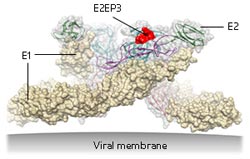Immunology: Vaccine hope for virile virus

A*STAR researchers have shown that the antibody produced in the initial immune response to CHIKV recognizes the protein E2 and binds to a specific site called E2EP3, seen here in red. This site projects from the surface of the virus, making it easily accessible to the antibody. © 2012 EMBO Molecular Medicine<br>
Chikungunya fever is a viral disease that has re-emerged to cause epidemics in the Pacific region within the last decade. It is caused by the Chikungunya virus (CHIKV), which is transmitted by mosquitoes and causes symptoms including fever, rash and joint pain.
It can be incapacitating, with some patients developing severe chronic symptoms, and it is sometimes fatal. The main current control measure is to prevent exposure to mosquitoes; a vaccine would reduce the threat of CHIKV.
Lisa Ng of the A*STAR Singapore Immunology Network and co-workers have now provided insight into the natural immune response that may help in developing a vaccine. Ng’s group showed previously that the initial immune response to CHIKV is spearheaded by a specific class of antibody that disables the virus when bound to it. Their latest research reveals a way to exploit this clinically.
Working with clinicians at the Tan Tock Seng Hospital, Ng and her team took blood samples from CHIKV-infected patients and tested them to see if they contained any antibodies that recognize proteins from the surface of the virus. They found that at early stages of recovery, patients’ blood contained large amounts of an antibody that targets a protein known as E2, which projects from the surface of CHIKV (see image). The same antibody was found in different groups of patients, showing that it is a reliable indicator of early infection.
The team confirmed that this antibody neutralizes CHIKV by adding blood samples to virus which was then used to infect susceptible human cells. If the blood samples contained the antibody, infection rates were reduced, whereas removing the antibody from the samples beforehand left infection rates high.
Having identified that the antibody recognizes E2, the researchers then tested its ability to recognize fragments of the protein. This allowed identification of the epitope, or the exact site on the protein, that the antibody binds to, which they called E2EP3.
When they vaccinated mice with a protein fragment equivalent to this epitope, the mice produced the same antibody in response. On subsequent infection with CHIKV, the vaccinated mice also showed milder symptoms, making the epitope a promising basis for a future vaccine in humans.
“[This study is] highly relevant for the rational design of CHIKV vaccines and for the development of diagnostics for optimal clinical management of patients,” says Ng. “It may also inspire similar studies with other arthritic arboviruses that in many parts of the world cause severe morbidity with extensive incapacitation.”
The A*STAR-affiliated researchers contributing to this research are from the Singapore Immunology Network and the Institute for Infocomm Research (I2R)
References:
Kam, Y-W et al. Early neutralizing IgG response to Chikungunya virus in infected patients targets a dominant linear epitope on the E2 glycoprotein. EMBO Molecular Medicine 4, 1–14 (2012). (Direct link to article below)
Media Contact
All latest news from the category: Life Sciences and Chemistry
Articles and reports from the Life Sciences and chemistry area deal with applied and basic research into modern biology, chemistry and human medicine.
Valuable information can be found on a range of life sciences fields including bacteriology, biochemistry, bionics, bioinformatics, biophysics, biotechnology, genetics, geobotany, human biology, marine biology, microbiology, molecular biology, cellular biology, zoology, bioinorganic chemistry, microchemistry and environmental chemistry.
Newest articles

Combatting disruptive ‘noise’ in quantum communication
In a significant milestone for quantum communication technology, an experiment has demonstrated how networks can be leveraged to combat disruptive ‘noise’ in quantum communications. The international effort led by researchers…

Stretchable quantum dot display
Intrinsically stretchable quantum dot-based light-emitting diodes achieved record-breaking performance. A team of South Korean scientists led by Professor KIM Dae-Hyeong of the Center for Nanoparticle Research within the Institute for…

Internet can achieve quantum speed with light saved as sound
Researchers at the University of Copenhagen’s Niels Bohr Institute have developed a new way to create quantum memory: A small drum can store data sent with light in its sonic…





















